Shake Shake Dont Come Back Again
Introduction:
There are many vehicle conditions that can cause your vehicle to shake. In short, anything that rotates can cause vibrations: Transmission, bulldoze line, brakes, motor mounts (ok, the motor mounts don't rotate, but if they're worn, they can allow vibrations to exist transmitted from the engine), and of course tires. Also, worn suspension parts can let for vibrations. Granted, tires are the most mutual cause of vibrations and they're usually the easiest to diagnose and cheapest to fix, but they are by no means the only cause of vibrations. In this article, we will requite some simple guidelines to "pre-diagnose" any shakes you have so yous'll know where to plough for help.
In this article nosotros'll cover:
- Shakes Not Acquired By The Tires
- Shakes Caused By The Tires
- Balancing and Balancer Types
Shakes That Are Non Acquired By The Tires:
It shakes when yous hitting the brakes, specially under difficult braking:
This is very common, and is most always acquired by warped brake rotors (or drums, simply usually rotors). The rotors are the part of the disc brake that rotates, and when yous apply the brakes, the calipers squeeze the rotor to make the vehicle slow down. Over fourth dimension, rut causes the rotors to warp and you get a pulsation in the pedal and often in the steering cycle, especially under difficult braking. If this is the type of shake you have, you should take the rotors checked for warping. If they are warped, they can exist machined (turned) to be straight again, only you tin can merely turn them a couple of times before they get too sparse, at which time they must be replaced.
The front end wobbles at a certain speed, merely not every fourth dimension you lot drive that speed:
Some vehicles can pick upward even violent wobbles (oscillation) at a sure speed, just non every time you bulldoze at that speed. This is usually caused by loose suspension parts or bearings. What happens here is that a loose suspension component can allow the front finish to start wobbling, similar when you striking a bump, and once the wobbling starts, you accept to boring downwards, or even cease to right it. Tires are very consequent, they will e'er practise the same thing at the same speed. So if the vehicle only wobbles some of the time, it is normally a loose or worn out suspension component that is to blame. In this case, you should run into your mechanic, or nosotros tin can wait for the cause if y'all want, only nosotros don't do this type of repair.
The vehicle wobbles while accelerating hard, or climbing steep hills
This type of vibration is usually caused by motor mounts. If they go worn, vibrations can show up when accelerating hard, or pulling hills. Experienced mechanics can diagnose this easily, and again, this is the realm of the mechanic.
In that location are actually many more types of "not-tire" related shakes, but these are merely some of the most mutual. Transmissions and drive lines can cause shakes too, but they are not quite as elementary to diagnose.
Shakes Acquired Past The Tires:
As stated earlier, tires are very consistent, they will wobble at the aforementioned speed every fourth dimension, whether, you're driving at a constant speed, braking, or accelerating. So if you car shakes at the same speed (or speeds) every time, tires are the first affair to check.
First Things First: Check for Cupping and Flat Spots
Cupping:
The elementary exam is to run your hand along the face up of the tire, and you tin can experience it. (Y'all may want to brand sure you don't have steel cords showing on the tire first, then you lot don't get cut!) If the tire is flat, so good, if information technology has small waves similar on the sea, you lot have cupping. Even though the tire in the picture is worn out, it clearly shows what nosotros mean by cupping. If you look along the edges of the tire, yous tin run into that one tread block is raised up, and the adjacent one in the row is almost completely smoothed out, then the next raised again. If you can imagine what this would feel like if you ran your paw along it, then you should exist able to imagine what this would feel like if it was mounted on your car!
Cupping can be caused past alignment bug, or inherent vehicle pattern issues. Rear tire misalignment on front wheel bulldoze cars is a textbook cause of cupping. In the heart movie you can clearly see the dished out spots on the left side of the tire, merely if y'all look carefully you lot can also see a diagonal "valley" in the tire. It goes from the outer flat spot towards the middle of the tire and down in the picture. Rear wheel misalignment will always testify this diagonal type pattern. If this type of wear shows up on rear of your front end wheel bulldoze car, the simply way to right it is to have a four bicycle alignment washed. You tin put new tires on information technology, but unless you have the rear of the vehicle aligned, it will only be a matter of time before the new tires are cupped also.
On the other hand, all kinds of vehicles, peculiarly 4 wheel drives, simply even high end European cars, tin can accept inherent design issues that tin cause cupping. On many of these vehicles, the only matter you tin exercise is continue the tires rotated, and if possible, choose tires with straight groove blazon treads. A directly (circumferential) tread tire volition loving cup less than more than aggressive tread tires. The tire pictured to a higher place is a skillful example of an ambitious tread tire used on a four bicycle bulldoze. The tire direct to the right is actually off a trailer, but is a skillful case of what we're talking well-nigh. Usually, having the car realigned and the tires balanced will not solve this type of trouble only should be done anyway as a precautionary measure.
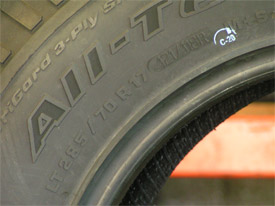
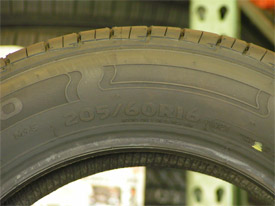
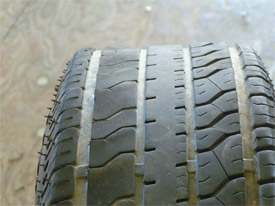
Apartment Spots:
Flat spots are caused by locking upward the brakes. This is not normally a problem if you lot have anti-lock brakes, only if you lot've had to stand on the brakes for any reason and had them lock upwardly, you lot can have apartment spots on your tires. If you've locked the brakes, and slid a long way, you volition definitely have flat spots. Simply run y'all hand along the tire once more, or visibly inspect it, making sure to turn the tire, (and then that you lot don't miss information technology if it'southward on the bottom). A flat spot is just what information technology sounds similar, instead of the tire having a round profile, there will be 1 spot on the tire that has been shaved off, (or flattened). You can experience it with your hand, or if you spin the tire, there will be an obvious dip when information technology gets to that spot. If it's not too bad, you can sometimes rotate the tires, since the front tires will usually be worse than the back. If not, the apartment spotted tires will have to be replaced.
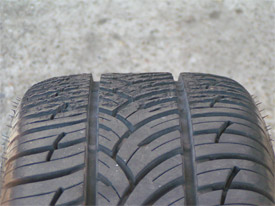
Over again, tires shakes are very consequent, they will always shake at the same speed(s). So if your tires take passed the first test, y'all tin can frequently tell what kind of a problem you have by the speed that the vehicle shakes (or wobbles) at.
Vehicle Wobbles At fifteen to 20 Miles Per Hour (mph)
If your vehicle wobbles at 15 to twenty, get direct to a tire store, practise not laissez passer go, do non collect $200.00, definitely practice not hit the freeway with your family unit in the machine, become directly to a tire shop. Though this can be caused by a severely bent cycle, or severe cupping, the nearly likely cause is a separated tire. Separated tires are a very serious safety issue, and must be dealt with immediately, since it's but a matter of time earlier the tire blows. A tire failure of this type about always causes impairment to the vehicle, simply that'southward nothing compared to the many fatalities that are cause by this. Practice not put this off!
To test for this, just drive the vehicle for a short distance at fifteen to 20 mph. If the bad tire is in the front, the steering volition rock back and forth, if information technology's in the rear, the rear of the machine volition wobble in a like manner. If you can observe out which tire is separating, it may be best to put the spare on right then and at that place, so that you lot tin actually make to the tire shop. The tire with the problem volition have a bump along the tread face which is visible, or you can experience it with you manus. If you use the hand test, the tire should accept a uniform profile except for the place where the separation is, which will exist distorted, ordinarily with office of the tread pushing away from the tire, ie.; a bump on the tread confront. The pictures beneath illustrate this: The picture on the left is the "normal" side of the tire and is pretty compatible, while in the film on the right, yous can see the "bump" where the tire is separating. This separation is pretty large, but they will always start out smaller, so you should wait for even small distortions in the tread face up.
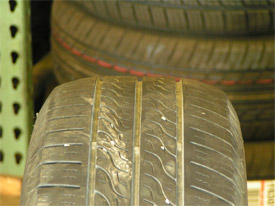
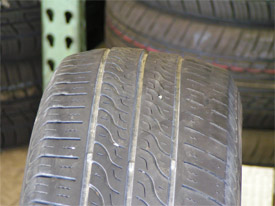
Vehicle wobbles at 30 to 50 mph:
The most common cause of vehicle wobbles in this speed range is a bent bike or mildly out of round tire. Manual and drive line issues can too testify up in this range, but tires are the starting time thing to check. Unlike the low speed wobble, this is usually non a safety result. Yous can usually meet the wobble in the tire/bicycle associates if you put it on the balancer. In many cases, the tire can be better matched to bicycle (high spot to low sport, or vice versa) and the wobble tin can be eliminated. (This is where the "Road Force Balancer" comes in, and we'll explicate that at the finish of this article.) If that doesn't work, the problem tire or wheel should be replaced. If the tires and wheels spin true and you withal have a trouble, then yous should accept a mechanic await at the vehicle.
Vehicle Shakes at 50 mph or higher
The most common cause of vehicle shakes at fifty mph or college is tire balance. Again, transmission or bulldoze lines tin can cause this, simply the tires should be the kickoff thing to have checked. A tire or wheel that is slightly bent or out of round can too be a cistron here, and this can be checked while the tire is on the balancer. Obviously, the get-go thing to bank check is the tire residual, and but afterward the tires have a clean bill of health should yous have information technology to a mechanic.
Balancers: Static, Dynamic and Road Force
Over the years there have been various methods of balancing tires. Without going into the history, we will simply explain the types in common utilise today, and when you would use i method or another.
Static Balancing
If you think of how your tires are mounted on the car, static balancing refers to balancing the tires only from up to down, or across the tire. In most cases, this works pretty well. Though not used very much these days, chimera balancers and "on the motorcar" balancers can only practise this type of balance. Also, if you lot don't want weights on the outside of your wheels, you will often become this blazon of balance. This is also called "single plane" balancing.
Dynamic Balancing
Dynamic balancing will not only balance the tire from up to down, but also from side to side, and is oft called "dual airplane" balancing. It is normal for tire/bike assemblies to be out of balance in both of these ways, and this makes a dynamic balancing a much meliorate choice than a static balancing. This can only be done past mod "computer" balancers, and requires weights to be put on both sides of the wheel. However, if yous want a skilful balance, and either your wheels won't take weights on the outside, or you only don't want the run into them, you lot tin often nevertheless have a 2 airplane remainder. Many modern vehicles are designed with "positive offset" wheels, which means that the commodities confront is pushed towards the outside, so almost of the wheel is inboard, towards the vehicle. In this blazon of wheel, it is easy to put the outer weights simply behind the face of the wheel and the inner weights on the within border. This allows for a proper dual plane remainder and is the preferred method (apart from weights on the outside edge). Yet, if you accept a standard get-go (bolt face in center of the wheel) or a reverse first bicycle (bolt face up toward the inside edge of the wheel), then you lot really can't go a proficient dual plane residual without putting weights on both sides of the wheel.
Road Force Balancing
Route strength balancing is a relatively new engineering science. The thought is that a "force wheel" is mounted on the balancer, (this is the black roller wheel on the right side of the balancer in front of the hood) and every bit the tire turns, the wheel pushes against the tire and measures variations in pressure around it's circumference. Since this simulates how the tire volition interact with the road, it is chosen "road force balancing". These balancers accept prescribed "tolerances" that allow different levels of "road forcefulness variation" for unlike types of vehicles.
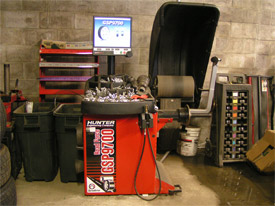
Finding out the "road force variation" of a tire is all well and skilful, simply if a tire/cycle assembly has too much variation, then what would you do? This is where these balancers smooth: Having recorded the road strength variation around the tire, the balancer then directs the technician to accept a reading of the bicycle. The software in the balancer then calculates whether the tire or the cycle is the problem, and whether or not the 2 can be "forcefulness matched" to meet the tolerances. If they can be matched, the balancer specifies a spot on the wheel, and a spot on the tire, where if the ii spots are matched together, (by turning the tire on the wheel) the tire/cycle assembly will so have the lowest possible road force variation. Granted, the machine doesn't always get it right the first time, and there are some tricks an experienced tire technician tin use to expedite the process, merely much of the time, problem tire/bicycle tin exist made to balance without having to exist replaced. This is important considering no tire manufacturer will replace a tire for existence "out of round" unless it is virtually make new. (This is fair because tires can go out of round over time for various reasons other than poor workmanship.) And then if your tires are even a little worn, this is ofttimes the only affair you can even exercise (curt or replacement, which you would have to pay for). Without a road forcefulness balancer, a tire can be matched for roundness (not force variation) by trial and error, but that tin can hateful turning each tire on it's wheel upwards to 8 times(!) and visually checking information technology on the balancer every time. Not but does this type of balancer greatly expedite the process, just the specific tolerances create an objective standard.
Obviously, we at Souza's use this type of balancer. However, since this procedure is time consuming, and in the majority of cases not necessary, nosotros don't road force every tire. We'd then take to raise our prices to pay for all the extra labor. Withal, if you have a problem that standard balancing won't prepare, we volition get to this next level and do everything we tin to set up your problem.
Back To Tires 101
Source: https://www.souzastireservice.com/Tires-101/Shakes-and-Wobbles
0 Response to "Shake Shake Dont Come Back Again"
Post a Comment